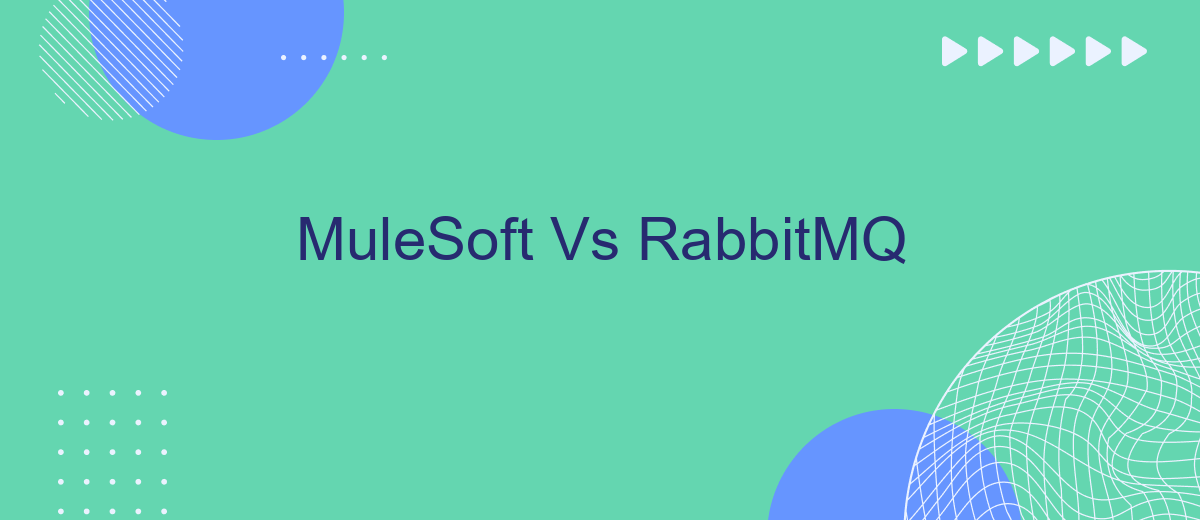In the landscape of enterprise integration, choosing the right tool can significantly impact your business operations. MuleSoft and RabbitMQ are two prominent players, each offering unique capabilities. While MuleSoft excels in comprehensive integration solutions, RabbitMQ specializes in robust message brokering. This article delves into the strengths and weaknesses of both, helping you make an informed decision for your specific needs.
Overview
MuleSoft and RabbitMQ are two powerful tools commonly used for integrating and managing data flows in various applications. MuleSoft is an integration platform that allows developers to connect applications, data, and devices with APIs. RabbitMQ, on the other hand, is a message broker that enables applications to communicate with each other through messaging protocols.
- MuleSoft: Focuses on API-led connectivity, offers a wide range of connectors, and provides a unified platform for integrating applications.
- RabbitMQ: Specializes in message queuing, supports multiple messaging protocols, and is known for its reliability and scalability.
Both MuleSoft and RabbitMQ have their unique strengths and use cases. While MuleSoft excels in complex integrations and API management, RabbitMQ is ideal for scenarios requiring reliable message delivery and queuing. For businesses looking to streamline their integrations further, services like SaveMyLeads can automate data synchronization between various platforms, enhancing overall efficiency and reducing manual effort.
Key Features Comparison

MuleSoft and RabbitMQ are both powerful tools for handling integrations, but they serve different purposes and have unique features. MuleSoft is an integration platform that provides a comprehensive suite of tools for connecting applications, data, and devices. It offers features like API management, data transformation, and orchestration, making it ideal for complex enterprise environments. MuleSoft's Anypoint Platform allows for seamless integration with various systems, including cloud services, databases, and SaaS applications, providing a robust solution for end-to-end integration needs.
On the other hand, RabbitMQ is a message broker that facilitates communication between different systems by sending and receiving messages. It excels in scenarios where decoupling and asynchronous communication are required. RabbitMQ supports multiple messaging protocols, high availability, and fault tolerance, ensuring reliable message delivery. While RabbitMQ focuses on messaging, it can complement integration platforms like MuleSoft by handling the messaging layer. For simpler integration tasks, tools like SaveMyLeads can be used to automate data transfer between different applications without the need for extensive coding, providing an efficient way to manage integrations with minimal effort.
Use Cases and Applications

MuleSoft and RabbitMQ serve different purposes and excel in various use cases and applications. MuleSoft is a versatile integration platform that connects diverse applications, data sources, and APIs, making it ideal for enterprises needing comprehensive integration solutions. RabbitMQ, on the other hand, is a robust message broker facilitating communication between distributed systems, suitable for real-time data processing and asynchronous communication.
- MuleSoft: Enterprise application integration, API management, data transformation, and orchestration.
- RabbitMQ: Real-time messaging, task queuing, microservices communication, and event-driven architecture.
For businesses looking to streamline their integration processes, tools like SaveMyLeads can be invaluable. SaveMyLeads offers automated workflows to connect various services and applications without extensive coding, complementing platforms like MuleSoft and RabbitMQ by simplifying the setup and management of integrations. This makes it easier for companies to maintain efficient and seamless operations across different systems.
Benefits and Limitations

MuleSoft and RabbitMQ offer distinct benefits and limitations that cater to different integration needs. MuleSoft, with its comprehensive Anypoint Platform, provides a robust solution for API management and integration. RabbitMQ, on the other hand, excels as a message broker, ensuring reliable message delivery and decoupling of services.
MuleSoft’s strength lies in its extensive connectivity options and pre-built connectors, which simplify the integration process. RabbitMQ’s advantage is its lightweight and efficient message queuing system, which supports multiple messaging protocols and patterns.
- MuleSoft Benefits: Comprehensive API management, extensive connectors, and robust integration capabilities.
- MuleSoft Limitations: Higher cost and complexity in setup and maintenance.
- RabbitMQ Benefits: Lightweight, efficient, and supports various messaging protocols.
- RabbitMQ Limitations: Limited to messaging and requires additional tools for complete integration solutions.
For businesses looking to streamline their integration processes, services like SaveMyLeads can be invaluable. SaveMyLeads automates data transfer between applications, reducing manual effort and ensuring seamless integration. This can complement both MuleSoft and RabbitMQ by simplifying and enhancing their integration capabilities.
Conclusion
In conclusion, both MuleSoft and RabbitMQ offer robust solutions for different integration needs. MuleSoft provides a comprehensive platform for API management, data integration, and application connectivity, making it ideal for complex enterprise environments. On the other hand, RabbitMQ excels in messaging and queuing, offering high throughput and reliability for distributed systems.
Choosing between MuleSoft and RabbitMQ ultimately depends on your specific requirements. For organizations seeking a versatile, all-in-one integration platform, MuleSoft is a strong candidate. Meanwhile, RabbitMQ is better suited for scenarios where efficient message brokering is crucial. Additionally, services like SaveMyLeads can complement both MuleSoft and RabbitMQ by automating lead data integration, further enhancing operational efficiency. By carefully evaluating your needs, you can select the most appropriate tool to streamline your integration processes.
- Automate the work with leads from the Facebook advertising account
- Empower with integrations and instant transfer of leads
- Don't spend money on developers or integrators
- Save time by automating routine tasks
FAQ
What is MuleSoft and what is RabbitMQ?
Which one is better for real-time messaging?
Can MuleSoft and RabbitMQ be used together?
What are the primary use cases for MuleSoft?
Is there a service that can help with automation and integration setup?
If you use Facebook Lead Ads, then you should know what it means to regularly download CSV files and transfer data to various support services. How many times a day do you check for new leads in your ad account? How often do you transfer data to a CRM system, task manager, email service or Google Sheets? Try using the SaveMyLeads online connector. This is a no-code tool with which anyone can set up integrations for Facebook. Spend just a few minutes and you will receive real-time notifications in the messenger about new leads. Another 5-10 minutes of work in SML, and the data from the FB advertising account will be automatically transferred to the CRM system or Email service. The SaveMyLeads system will do the routine work for you, and you will surely like it.

